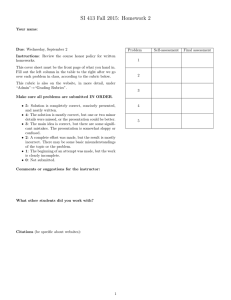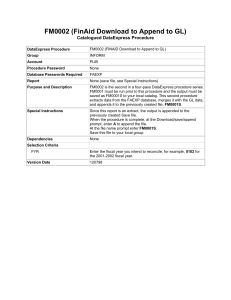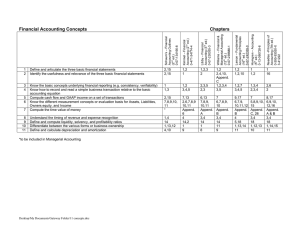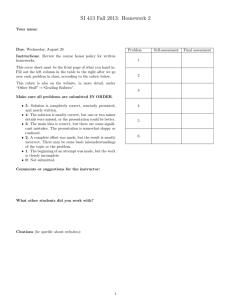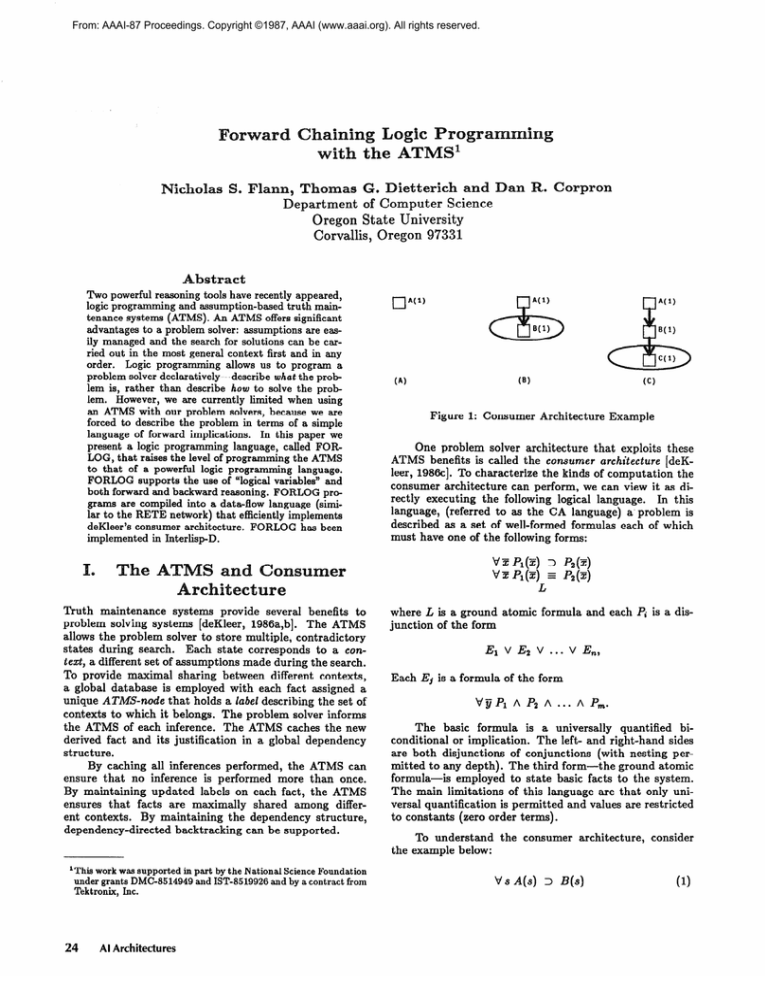
From: AAAI-87 Proceedings. Copyright ©1987, AAAI (www.aaai.org). All rights reserved.
aining Logic Progra
the ATMS1
Nicholas S. Flam, Thsrnas 6.
iettdch
and
Department
of Computer Science
Oregon State University
Corvallis, Oregon 97331
Abstract
Two powerful reasoning tools have recently appeared,
logic programming and assumption-based truth maintenance systems (ATMS). An ATMS offers significant
advantages to a problem solver: assumptions are easily managed and the search for solutions can be carried out in the most general context first and in any
order.
Logic programming allows us to program a
problem solver declaratively-describe
whet the problem is, rather than describe how to solve the problem. However, we are currently limited when using
an ATMS with our problem solvers, because we are
forced to describe the problem in terms of a simple
language of forward implications.
In this paper we
present a logic programming language, called FORLOG, that raises the level of programming the ATMS
to that of a powerful logic programming language.
FORLOG supports the use of “logical variables” and
both forward and backward reasoning. FORLOG programs are compiled into a data-flow language (similar to the RETE network) that efficiently implements
deKleer’s consumer architecture.
FORLOG has been
implemented in Interlisp-D.
(8)
(A)
Figure
1: Consumer
(Cl
Architecture
Example
One problem solver architecture that exploits these
ATMS benefits is called the consumer architecture [deKleer, 1988c]. To characterize the kinds of computation the
consumer architecture can perform, we can view it as directly executing the following logical language. In this
language, (referred to as the CA language) a problem is
described as a set of well-formed formulas each of which
must have one of the following forms:
vz P&E)3 P&e)
VzP,(z) E P&)
L
Truth
maintenance
systems
provide
several
benefits
to
problem solving systems [deKleer, 1986a,b].
The ATMS
allows the problem solver to store multiple, contradictory
states during search. Each state corresponds to a COW
tezt, a different set of assumptions made during the search.
To provide maximal sharing between different contexts,
a global database is employed with each fact assigned a
unique AT&&S-node that holds a label describing the set of
contexts to which it belongs. The problem solver informs
the ATMS of each inference. The ATMS caches the new
derived fact and its justification in a global dependency
structure.
By caching all inferences performed, the ATMS can
ensure that no inference is performed more than once.
By maintaining updated labels on each fact, the ATMS
ensures that
ent contexts.
facts are maximally
shared among differBy maintaining
the dependency
structure,
dependency-directed
backtracking can be supported.
‘This work was supported in part by the National Science Foundation
under grants DMC-8514949 and IST-8519926 and by a contract from
Tektronix, Inc.
24
Al Architectures
where L is a ground atomic formula and each Pi is a disjunction of the form
El v E2 v . . . v En,
Each Ej is a formula of the form
VjjPl
A Pz A . . . A P,.
The basic formula is a universally quantified biconditional or implication. The left- and right-hand sides
are both disjunctions of conjunctions (with nesting permitted to any depth). The third form-the ground atomic
formula-is
employed to state basic facts to the system.
The main limitations of this language are that only universal quantification is permitted and values are restricted
to constants (zero order terms).
To understand the consumer architecture,
the example below:
VsA(s)
I
B(s)
consider
(1)
tr’¶ %?) 3 C(q)
A(l)*
(2)
(3)
The problem solver performs forward chaining. Whenever the antecedent pattern (e.g., A(s)) of any implication is satisfied by a conjunction of facts in the database
(e.g., A(l)), the implication “fires.” A job, called a consumer, is put on the problem solver’s global agenda. Each
consumer is assigned an ATMS-node that is justified by
the ATMS-nodes of the facts that satisfied the antecedent
pattern. Hence, consumers are already linked into the dependency structure even though the resulting assertion,
B(l), has not been entered into the database (see Figure
l(b)). The consumer’contains the “detached” consequent
of the implication (B( 1))) f ormed by instantiating the right
hand side of (1) with the bindings generated from the antecedents. Problem solving proceeds by picking consumers
off the agenda and running them. When a consumer is
run, the new detachment is asserted into the database,
possibly satisfying other implications and generating new
consumers. When B(P) is asserted, a new consumer is generated (through satisfaction of (2)) and put on the agenda,
as illustated in Figure l(c).
The consumer architecture has many advantages. Inferences can be made in any order and in any context. No
inferences are missed, and no inferences are done twice.
This is possible because the consumer architecture solves
the un-outing problem. This problem arises when a line of
reasoning is interrupted, so that reasoning can proceed in
a different context. The un-outing problem is the problem
‘of resuming the reasoning in the previous context. DeKleer solves this problem by imposing three conventions on
the problem solver:
The problem solver must keep the ATMS fully informed. All information that the problem solver uses
in making an inference (i.e., all the antecedent facts)
must be reported to the ATMS as justifications for
the resulting consumer.
e A clear distinction is drawn between the problem
solver and the ATMS. The problem solver must generate all consumers irrespective of the status of their
labels. Even if a consumer’s support is currently believed to be contradictory, the consumer must be produced and put on the agenda. This ensures that the
inference will be made if ever the supporting context
is un-outed.
The problem solver’s state is explicit. A consumer,
although it is part of the problem solver’s state, is
like a “virtual” fact. It has an ATMS-node and is
linked into the dependency network, but has not been
asserted, and hence has no consequences. By linking it
into the dependency structure, the ATMS ensures that
any changes to the consumer’s underlying support will
be reflected in the consumer’s label.
The un-outing problem is elegantly solved. To move between contexts, we choose consumers from the agenda (by
inspecting their labels), rather than choosing implications
to fire.
The advantages afforded by the consumer architecture and the CA language are apparent. Unfortunately,
there are significant limitations that currently restrict the
usefulness of the ATMS. We identify the following related
problems:
Lack of expressiveness.
The CA language limits variables to be universally quantified-we
are unable to
exploit the power of the existentially quantified variable. Values are limited to constants. The representational power of terms for capturing structured objects,
such as trees and lists, is not available.
Lack of reversibility.
Both the CA language and consumer architecture offer no support for logical variables. This is because we are restricted to ground
facts. To illustrate the usefulness of logical variables,
consider the time-honored append program in Prolog
[Clocksin and Mellish, 19841, [Sterling and Shapiro,
19861. Without logical variables, we can only ask questions of the form: uppend([l], [Z, 3l,[J, 2,3/). Logical
variables stand for computed answers and allow us to
“run” the program in many ways-as a generator*of
solutions rather than as just a test of solutions. For
example, in Prolog we can solve, uppend([l],[Z,?l],A)
and get back that A=[1,2,31. In fact, if we give Prolog
awend(X K [A 2,31) we get all four possible answers
back as values for X and Y. Hence, by employing logical variables, we can exploit the denotational aspect
of logic programs through reversible execution.
Only forward reasoning is possible. The consumer architecture and ATMS are limited to forward reasoning
only. This is because the ATMS relies on each derived
fact having a justification-a
set of antecedent facts.
Hence, the direction of inference must be the same as
the direction of logical support. In forward chaining,
we reason from antecedents to consequences, but in
backward chaining we go the other way-from consequences to antecedents. Hence, we have no justifications (until the problem solving is complete).
FCRLCG raises the level of programming the consumer
architecture to that of a powerful programming language,
while retaining all the advantages afforded by the ATMS.
This is achieved by significantly extending the CA language and the underlying consumer architecture to overcome the problems identified above. The CA language is
generalized to include most of first order logic, including
existentially-quantified variables and arbitrary term struttures. The consumer architecture is correspondingly extended to support these new features. Logical variables are
implemented through their logical equivalent, Skolem constants, while unification is replaced by equality reasoning.
Finally, FCRLCG supports backward reasoning by reformulating it into a form of forward reasoning that yields
identical behavior (but different logical semantics).
A.
F
A FORLCG program is a set of well-formed formulas similar to CA language, except:
Each Pi is a disjunction of the form
Fl v F2 v . . . v F,,
, Flann, Dietterich, and Corpron
25
where each Fj is an existentially
quantified formula of the
form
3y Pl A Pz A . . . A P,
or
G.
The basic formula allows both the left- and right-hand
sides as disjunctions of existentially-quantified conjunctions (with nesting permitted to any depth). The ground
literal is replaced by G-a predicate that may contain constants, Skolem constants and arbitrarily term structures.
To clarify our description of FORLOG, we first give an
example of FORLOG running the ubiquitous append program.
Consider the following FORLOG program, which is
derived from the Prolog append program.
3
xl,xrpzr
v 2, Y, 2 apwnd(x, Y, 2) 1
(x= [] A y = 2) v
z = [ZIIG] A z = [zllzr] A append(sr,y,zr)
(4
(5)
The symbol slur is a Skolem constant. From this program,
FORLOG generates the following inferences.
By satisfying (4) with (S), FORLOG obtains
apwnd([l],
[2,3], ski)
([I] = [ ] A j&3] = sh) V
The first branch of this disjunction is obviously false, because the list [I] is not nil. Hence, FORLOG can infer
that the second branch is correct. Because the cons function is a constructor, we can infer from [l] = [zr]z,.] that
Xl = 1 and x, = [ 1, and we can substitute these values
for all occurrences- of the existential variables 51 and x,.
Unfortunately, we cannot infer the value of z,, but we can
Skolemize it to be &. This reasoning produces
Sk1 = [I]&]
(7)
awnd([ I, [2,3], S~Z)
(8)
Formula (8) is, in a way, a recursive subgoal, and it
can be applied to axiom (4) in the same way as the original
assertion (5). When this is done, FORLOG obtains
(I]=[]
(3
A [W]=sh)v
zl~~c~zr [] = [xllG] A Sk2 =
A append( xr, [2,3], G))
[xllzr]
(9)
This time, the second branch of the disjunction can be
ruled out, for it is impossible for [xl lz,] to ever be equal
to [ 1. In the first branch of the disjunction, [ ] = [ ] tells
us nothing, but the remaining fact
P, 31 = Sk2
(10)
completely determines the value of ski. Indeed, from assertions (7) and (lo), FORLOG infers that
ski = [l, 2,3].
26
Al Architectures
This example demonstrates that FORLOG can execute append in much the same way that Prolog does. However, where Prolog would use “logical variables,” FCRLOG
uses Skolem constants, and where Prolog would use unification, FORLOG employs equality reasoning.
Thus, we can do “backward chaining” in FORLOG
but in such a way that the direction of inference is the
same as the direction of logical support. Hence, we have
satisfied one of the constraints of the consumer architecture. We obtain the FORLOG append program directly
from the Prolog program by first taking the completion
[Clark, 19781. The basic idea of the completion operation
is to find all the knozon ways of proving a predicate P (i.e.,
all the clauses with append as head) and assert that these
are the only way to prove P. Once we have done this we
can, without affecting the semantic content, change the implication (from clauses to head) into an equivalence ( z ).
The FORLOG program is simply the other half of this
equivalence (compared with Prolog). Hence, through this
method, we can reverse the implication and align it with
the direction in which we wish to reason. For more details,
see [Corpron et al., 19871 and [Corpron, 19871.
(11)
Before we describe how FORLOG is implemented, we review the requirements imposed on a problem solver by the
consumer architecture:
1. If the antecedent pattern of any implication is satisfied by a set of facts in the global database, then the
consequent must be detached.
2. Detaching a consequent must generate all the relevant
consumers, each having a form suitable for satisfying
other antecedent patterns and each justified by all the
antecedent facts.
The following section describes how the FORLCG
problem solver sat i&es these requirements.
A.
FORLOG
agld
the
Cc~nsumer
As&i-
tecture
Running a FORLOG program entails applying a restricted
theorem prover to the set of FORLOG expressions. The
theorem prover basically applies msdecs ponens-detaching
consequences when the antecedents are satisfied. In other
words, we implement this theorem prover in the consumer
architecture. Pn our description of FQRLOG below, we
emphasize both logical and implementation issues.
First, consider point 1 above, the satisfaction sf antecedents. In both FORLOG and the CA language, an
antecedent pattern consists of a disjunction of conjunctions of predicates, nested to any depth. We need only
consider a DNF form, since any deeply nested expression
can always be “multiplied out” to DNF form. Each disjunct can easily be implemented as a separate conjunctive
pattern in a RETE network [Forgy, 19821. When we are
dealing only with ground facts, the RETE implementation
provides an efficient method of determining when patterns
are satisfied. However, because FORLOG supports Skolem
constants, this basic mechanism is insufficient. Consider a
simple example:
‘ifs P(s)
A Q(s)
1 Z(s)
(12)
If we know the facts P(2) and Q(2), we know that (12)
is satisfied. But if we only know P(3) and Q(skl),
we
cannot directly determine if (12) is satisfied. If at a later
time the problem solver determines that ski = 3, then
(12) is satisfied with support, ski = 3, P(3) and Q(sk1).
Hence, we must supplement the simple RETE implementation with an equality system whose responsibility is to determine whether antecedent patterns are satisfied through
equality information such as skl = 3.
In both FORLOG and the CA language, a detached
consequent is always converted into a collection of atomic
formulas before being asserted into the database. This policy serves to simplify the subsequent task of determining
which implications are triggered by these assertions.
In the CA language, this process is straightforward,
since we only have universal quantification. Again we need
only consider the DNF form. Each disjunct of the detached
consequent will be a conjunction of ground atomic formulas since the literals will be completely instantiated with
constants from the antecedent satisfaction. Each of these
ground facts produces a single consumer. There is a complication when we have more than one disjunct, since we
may not know which of the disjuncts are true. Consider
the following example:
V w adult(w)
1
V man(w)
woman(w)
(13)
If we know aduZt(Chris) , we cannot determine which disjunct is true, so we must assume both are true. In other
words we apply the following axiom:
aIbVc
I- a
>
[Choose(B,
aAB1
aACIc]
C}
b
(14
where upper case letters denote new assumptions and
Choose{B,C}
informs the ATMS that B V C is true.
Hence, we create a new assumption for each disjunct and,
since the antecedent is satisfied, put two consumers on the
agenda:
1)
2)
Assertion
woman( Chris)
man( Chris)
Justification
(fw
(A %
(15)
where A is the ATMS-node of adult(Chris)
and 63 stands
for “assume that Chris is a wornann and C stands for “assume that Chris is a man.”
In FORLOG, detaching consequents is significantly
more complex because of the use of existential variables.
There is insufficient space to describe how all consequents
in FORLOG are detached, we will simply follow the append
example introduced in section B. (see [Dietterich, Corpron
and Flann, 19871).
When we detach the consequent of the append example (4), we first try to determine which of the disjuncts is
true. To do this we apply the following axiom:
a V b I- (-a
I
b) A (lb
5
a).
(16)
If we know one branch of a disjunction is false-the other
must be true. By applying this axiom, FORLCG can avoid
the unnecessary generate and test involved in applying
(14). In step (9) of the example, we determined that the
first branch of the disjunction was true and formed the consumer given in step (10). In step (6) the second disjunct
was ruled in. Here we first perform two unifications, one
of which produced the consumer (7) and then instantiated
the append form to obtain the consumer (8).
To perform these unifications and determine the disjunct, FQRLCG applies the following axioms: If f and 9
are distinct constructors, then the following identity theory
must hold:
f (Xl, . . ..GJ
Xl # Yl
f(%...
v
*- - v
, &a)
f(z)
=
# x
xn
f(Y1,
#
f(z)
Yn
#9(Yl,-,Ytn)
1
f(xl,
***9&a)
#
f(Yl9.*-9Yrn)
- - - 9 yn)
3 x1 = yl A . . . A x, = y,,
is any term in which x is free
(17)
In other words, the entities denoted by two constructors
are equal if and only if all of their components are equal
(unifiable).
In general, detaching a consequent in FCRLCG involves a complex sequence of actions. In the append example, we first determine the branch. Then we may perform
some unifications and, depending upon the unifications,
create Skolem constants. Finally we produce consumers.
Rather than determine which steps to perform each time
we detach this consequent, we “compile” the append’implication into a form that will automatically perform these
actions each time we detach. This form is described in the
next section.
a
FO
implemenatatisn
FQRLQG implications are compiled into a data-flow
like language. that has much in common with the RETE
network [Forgy, 19821 and the Warren Abstract Machine
(WAM, [Warren, 1983)). In general, an implication is compiled into a network. The roots are input patterns that are
satisfied by facts in the data base, while the leaves specify
consumers to be created. This is illustrated by the network
constructed for append given in Figure 22. Execution consists of passing jobs down the Uwires”from top to bottom.
Jobs get created at the top when input patterns are satisfied by the global database, and get “consumed” at the
leaves when they are used to create consumers. The consumers created are then run by the consumer architecture
and satisfy further input patterns, thus generating new
jobs. Hence, FORLCG is implemented as a data flow machine whose network is “sliced.” Each slice represents a
global communication, via the database, between output
and input nodes in the network.
To illustrate this data-flow language, we continue with
the append example presented in Section B, At step (8)
when
(APPEND
NIL (CONS 2 (CONS 3 NIL)) SW)
2Universal variables are denoted by $ prefixes, existential variables
are denoted by # prefixes. The basic constructor
in FORLOG is
the function CONS. Finally, # denotes anything.
Flann, Dietterich, and Corpron
27
~(APPEND
sx
SY Sz)(
I
Oneof.l.Srl
(OR
(NOT
(-
SX
I
I
Figure 2: Data-flow implementation of FORLOG
is asserted, the pattern (APPEND $X $Y SZ) is satisfied,
creating the following data-flow job:
bindings : (($X . NIL)($Y . (CONS 2 (CONS 3 NIL)))
($Z . SK2))
support : (D),
(18)
where D is the ATMS-node of (8). This job passes through
the New Detachment node (which will be discussed later)
to the Oneof nodes. The oneof nodes allow us to simply
determine at run time the correct disjunct. To do this, we
instantiate the expressions in the nodes with the bindings
on the job, and apply the identity theory (17). In this
example, the resulting expression in the right-most oneof
node is
(OR
$
(NOT (= NIL (CONS # #)))
(NOT (= SK2 (CONS # #)))),
(19)
which is true, because NIL does not equal a constructor.
Hence, this job is passed down the right-most branch.
When the job reaches the leaves, we create a consumer
that asserts the equality between the binding on SY and
the binding on SZ, corresponding to step (10) above.
To demonstrate how unifications are compiled and
run, we follow the first append goal assertion (5) :
(APPEND
(CONS 1 NIL) (CONS 2 (CONS 3 NIL)) SKl).
In this case, the left-most Oneof node is satisfied through
(OR
(NOT (= (CONS 1 NIL) NIL))
(NOT (= (CONS 2 (CONS 3 NIL)) SKl))),
The compiler enumerates the possible combinations and
constructs the decision tree illustrated in Figure 2. In this
case, the job passes down the decision tree to the Skolemize
#XR-2 node, where the new Skolem constant is generated
and added to the bindings of the data-flow job. Finally
the job is propagated to both the leaves, leading to the
consumers given in (7) and (8).
Note how the network is shared between the different
detachments. To ensure detachments are separated from
each other, the New Detachment node generates a unique
name that is associated with each data-flow job that passes
through.
This example does not demonstrate how FORLOG
handles the case when we are unable to determine the disjunct. For example, if we assert
(APPEND SK3 SK4 (CONS 1 NIL))
(21)
and evaluate the instantiated expressions of the Oneof
nodes, we are unable to determine directly which disjunct
is true. There is not enough information available to completely evaluate these equalities. FORLOG therefore partially evaluates them and sets up “listeners” that w.ill trigger when the evaluation can proceed further. In other
words, we are implementing the equality axiom of substituting equals for equals by rewriting the patterns rather
than rewriting the facts. For example, consider the first
disjunct of the right-most oneof node following (21):
(NOT (= SK3 (CONS # #))).
(20)
and the data-flow job passes down the network to the left.
Recall from the definition of append (4) that the second
disjunct involves unification of both $X and $Z. Each unification can be used in two ways: in read mode or in write
mode [Warren 19831. Read mode corresponds to unifying
the pattern with existing structure, for example, in the first
unify node SX.
(= (CONS 1 NIL) (CONS #Xl-l
Append
#XR-2)).
The partial evaluator translates this (through the use of
the equality axiom) into:
(AND (= SK3 $1) (NOT (= $1 (CONS # #))I).
The first clause acts as a “1isteneP for any object that
is asserted equal to SK3. while the second clause tests
whether the object is not a constructor. This process is
implemented by simply extending the data-flow network
at run time. The listener becomes a new input pattern
that connects to the right-most oneof node.
If we later determine a value for SK3,
Write mode corresponds to constructing new structure, for
example, in the second unify node $Z,
(= SK3 NIL)
(= SK1 (CONS 1 #ZR-3).
The listener is satisfied, and a job created and passed down
28
Al Architectures
(22)
the network, eventually producing the following consumer:
(=
Assertion
SK4 (CONS I NIL))
Justification
(CD),
(23)
where C is the ATMS-node of (21) and D is the ATMSnode of (22).
This value of SK3 ((22) above) could come directly
from an assertion or from equality reasoning. For example, the system may first determine that another Skolem
constant, say SKlO. is equal to NIL. then determine that
SK3 equals SKIO. Hence, to ensure that point 1 in Section
III. is satisfied, the supporting equality system needs to
apply the reflexive and transitive laws of equality.
The problem may be so unconstrained that values for
SK3 and SK4 are not available. In this case, FORLOG
enumerates both branches by applying the method presented in (14). H ence, FORLOG can exploit the ATMS to
explore alternative solutions in any order.
.
FORLOG is a forward chaining logic programming system
that combines the flexible search and assumption handling
of the ATMS with the clean denotational semantics, expressive power, and reversibility of logic programming.
nowledgme
This research was supported in part by the National Science Foundation under grants DMC-8514949 and IST8519926 and by a contract from Tektronix, Inc. We thank
both Cohn Gerety, who implemented the ATMS, and the
students of the spring 1986 Non-monotonic Reasoning class
who used FORLOG for their projects. We also thank Caroline Koff and Ritchey Ruff for their valuable comments
on earlier drafts of this paper.
eferenees
[Clark 19781 N eg a t’ion as Failure. In Logic and Databases,
H. Gallaire and J. Minker Eds. Plenum Press, New
York, pp. 293-322.
[Clocksin, and Mellish, 19841 Programming
in Prolog.
Berlin: Springer-Verlag.
[Corpron, 19871 Disjunctions in Forward-Chaining Logi
Programming. Rep. No. 87-30-l. Computer Science
Department, Oregon State University.
[Corpron, Dietterich, and Flann, 19871 Forthcoming. Viewing Forward Chaining as Backward Chaining.
[deKleer, 1986a] An Assumption-based
Intelligence, 28 (2) pp. 127-162.
TMS.
Artificial
FORLOG is completely implemented and running in
We&p-D.
Problems solved include the bulk of the Prolog examples given in the early chapters of [Sterling and
Shapiro, 19861 and some simple constraint propagation
problems such as those in [Steele, 19801. In addition, a
small expert system for designing cloning expriments has
been constructed in FORLOG.
[deKleer, 1986b] Extending the ATMS. Artificial Intel&
gence, 28 (2) pp. 163-196.
[deKleer, 1986c] Problem-solving with the ATMS. Artificial Intelligence, 28 (2) pp. 197-224.
[Dietterich and Ullman, 19871 FORLOG: A Logic-based
Architecture for Design. Rep. No. 86-30-8. Computer
Science Department, Oregon State University.
[Dietterich, Corpron and Flann, 19871 Forthcoming. Forward chaining Logic Programming in FORLOG.
[Forgy, 19821 RETE: A Fast Algorithm for the Many Pattern/Many Object Pattern Match Problem. Artificial
Intelligence, 19.
In this paper we have used a rather pathological, but
well known example-append.
FORLOG is currently being applied to solving more complex problems including
mechanical design problems. In this domain, FORLOG’s
ability to both manipulate partial designs (through the use
of Skolem constants) and to reason simultaneously with
multiple contradictory designs, gives it a significant advantage over other logic programming systems [Dietterich
and Ullman, 19871.
[Steele, 19801 The definition and implementation of
a computer programming language based on constraints. Doctoral dissertation. Massachusetts Institute of Technology.
[Sterling, and Shapiro, 19861 The Art of Prolog,
MIT
Press, Cambridge, Mass.
[Warren, 19831 An Abstract Prolog Instruction Set.
Technical Note 309, SRI International, Stanford, October 1983.
This was achieved by extending deKleer’s simple CA
language to include much of full, first order logic and
by augmenting the problem solving architecture so that
Skolem constants can be supported.
Flann, Dietterich, and Corpron
29

